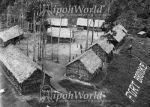We've tried to ensure the information displayed here is as accurate as possible. Should there be any inaccuracies, we would be grateful if you could let us know at info@ipohworld.org . All images and content are copyright.
(Please click on the thumbnail for a bigger image.)
Fort Brooke - An Aerial View Of The Fort Buildings

The photograph, courtesy of Roy Follows, shows an aerial view of Fort Brooke, a Police Field Force (PFF) jungle fort (VE 38 83) named after Lt Colonel Oliver Brooke DSO MBE of 22 SAS (Special Air Service). One of the 12 forts built to combat the Communist control of the Orang Asli, it was dependant on helicopters as unlike most of the other forts, it had no airstrip for fixed wing aircraft.
The author of the above book, S R Follows (Roy) was born July 1, 1929 in Newcastle-under-Lyme, England. After completing two years National Service in the British Army, he joined the Merchant Navy, where he served for three years aboard a passenger ship. After leaving the Merchant Navy he enlisted in The Malayan Police Force of The British Colonial Police at the rank of Police Lieutenant. He arrived in Malaya in 1952, at the height of the Malayan Emergency.
In 1954, after two years of leading jungle patrols, Follows was appointed Commander of Fort Brooke, in the mountains on the Perak/Kelantan border. As commander, Follows was given the responsibility of "winning over" the Temiar tribe who had previously been under the control of Communists. During the 8 months he spent at Fort Brooke, he became friendly with the Temiar and convinced a pro-communist Temiar headman to surrender to him.
Upon his departure from Fort Brooke in May of 1955, Mentri Awol, the headman of a nearby Temiar tribe, presented Roy Follows with his personal blowpipe. Follows continued to serve with the Royal Malaysian Police Force until Novermber 1960.
To view details of Colonel A E Young and the strategy of the Jungle Forts, click here.
To read more about the Jungle Fort and Airstrips, click here.
For a short introduction to the Malayan Aborigines, click here.
To find the details of Roy’s book, “The Jungle Beat”, click here.